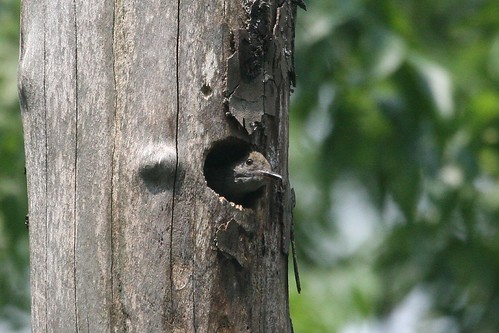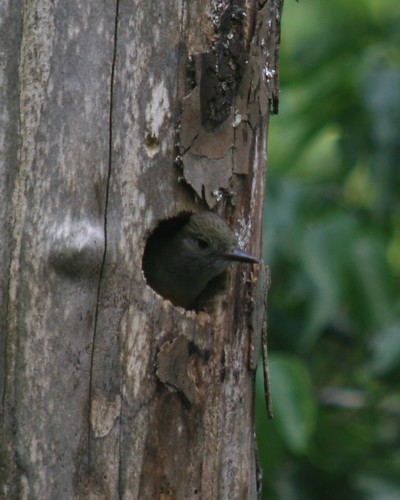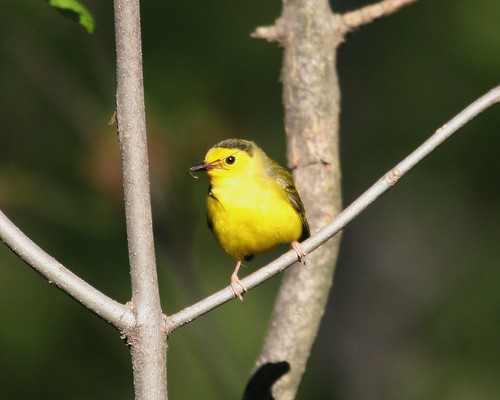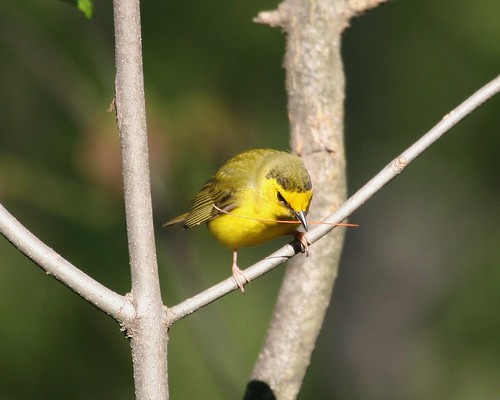One of my recent hikes on South River Falls Trail (back in May) yielded the usual menagerie of spring migrants, including some that nest in the mountains of Virginia. One species in particular that nests in Shenandoah National Park is Hooded Warbler.
At the very start of my most recent visit, Tammy and I came across a Hooded Warbler that appeared to be gathering nesting material. I took several photos of the bird as it moved about the bushes very close to the ground. It was quite shady in those spots, so I set the ISO on my camera up to 400 in an attempt to compensate for the low light. When the bird suddenly perched in direct sunlight, I had time to snap several pictures that turned out to be above average. Unfortunately I did not have a chance to readjust the ISO back down to 100 before taking these, so they are a bit overexposed. But I will take what I can get :-)
Showing posts with label Nesting. Show all posts
Showing posts with label Nesting. Show all posts
Great Horned Owl On Nest
While Tammy and I were in Everglades National Park, we heard from another visitor (who, in turn, had heard from a local birding club doing a Christmas Bird Count) of where we could see a Great Horned Owl sitting on a nest. I love seeing owls, so I wasn't going to miss the opportunity to see one on a nest. Tammy and I found the nest, but were later told by a park ranger not to advertise the location because the nest might get endangered.
At first I was thinking that the danger was simply too much human interest in the nest and the stress to the birds that would accompany the human traffic. But the park ranger explained that an owl's nest was a target for egg collectors. Egg collecting?
Okay. Obviously there was something here that I was (and still am) a bit naive about. A few Google searches later, however, and I have learned a new word: oology. The collection of wild bird eggs is an old hobby that evolved into something much more formal and science based. The collection of eggs, however, has some serious conflicts of interest. An egg taken for something as positive sounding as scientific study is an egg that will not hatch into a new generation, which puts even more pressure on a species that might need all the help it can get. Here is an article written for the October 2005 edition of Birder's World magazine that provides very good background on this subject. And here is a letter to the editor of a magazine called Birds and All Nature, published in May 1899 (yes...1899!) that provides a decidedly negative opinion of the collection of eggs. Ironically, the letter writer also states that collecting and mounting specimens of birds is not all that bad.
So, here is that Great Horned Owl sitting on her nest. I took this photo from an undisclosed located within Everglades National Park. Hopefully one more generation of owl will fledge from this nest.
At first I was thinking that the danger was simply too much human interest in the nest and the stress to the birds that would accompany the human traffic. But the park ranger explained that an owl's nest was a target for egg collectors. Egg collecting?
Okay. Obviously there was something here that I was (and still am) a bit naive about. A few Google searches later, however, and I have learned a new word: oology. The collection of wild bird eggs is an old hobby that evolved into something much more formal and science based. The collection of eggs, however, has some serious conflicts of interest. An egg taken for something as positive sounding as scientific study is an egg that will not hatch into a new generation, which puts even more pressure on a species that might need all the help it can get. Here is an article written for the October 2005 edition of Birder's World magazine that provides very good background on this subject. And here is a letter to the editor of a magazine called Birds and All Nature, published in May 1899 (yes...1899!) that provides a decidedly negative opinion of the collection of eggs. Ironically, the letter writer also states that collecting and mounting specimens of birds is not all that bad.
So, here is that Great Horned Owl sitting on her nest. I took this photo from an undisclosed located within Everglades National Park. Hopefully one more generation of owl will fledge from this nest.
Great Crested Flycatcher - Revisited
A couple posts back I shared a few pictures that I took of a Great Crested Flycatcher using my digiscoping rig, and commented on the results, my technique and my expectations. All in all, my jury is still out on digiscoping, but I am definitely going to be trying it some more. For example, next month Tammy and I are going to spend a week in and around Yellowstone National Park, and I expect that there will be more than a few chances to photograph far away wildlife in a setting that is controlled enough for me to digiscope.
The phrase "controlled enough" is key. I am not skilled enough with the digiscoping rig yet to be able to quickly point to a new, or just moved target, and then get it in focus. I still need a non-trivial amount of time to do that (relative to the time I need when I am simply using my camera with a telephoto lens).
As an example, here are a few more photos of the same Great Crested Flycatcher, but these were not digiscoped. Instead these were taken with my normal camera configuration: hand held Canon EOS 30D + Canon EF 100-400mm 4.5-5.6 L IS. I think the quality of these are better than those I obtained when digiscoping, but more importantly, I would never have even gotten these photos if I had been trying via digiscope. My chosen subject was way too active for me to keep up with it when using the scope.



The phrase "controlled enough" is key. I am not skilled enough with the digiscoping rig yet to be able to quickly point to a new, or just moved target, and then get it in focus. I still need a non-trivial amount of time to do that (relative to the time I need when I am simply using my camera with a telephoto lens).
As an example, here are a few more photos of the same Great Crested Flycatcher, but these were not digiscoped. Instead these were taken with my normal camera configuration: hand held Canon EOS 30D + Canon EF 100-400mm 4.5-5.6 L IS. I think the quality of these are better than those I obtained when digiscoping, but more importantly, I would never have even gotten these photos if I had been trying via digiscope. My chosen subject was way too active for me to keep up with it when using the scope.



Great Crested Flycatcher
In my previous post, I mentioned that while at DGCA I happened upon a pair of Great Crested Flycatchers tending to a nest. They would both be out searching for food at the same time, each returning to bring nestlings a nice juicy bug. Of course, that is an assumption. I only really saw one bird at a time, so maybe it was the same one each time.
The comings and goings of the flycatchers were good fodder for one of my purposes of this particular trip: practice digiscoping. So I set up my tripod, scope and camera, attached the remote shutter release, and then began trying to get a bird in scope long enough for me to get it in focus and take a few pictures.
The results are varied, with none of the pictures coming out excellent. A few were underexposed. Many were slightly overexposed. None had the bird in super sharp focus. As I hinted in the previous post, I am not sure if I need to change my technique or my expectations. Here are a couple of the photos that I felt were on the better end of the menagerie that I captured.


The comings and goings of the flycatchers were good fodder for one of my purposes of this particular trip: practice digiscoping. So I set up my tripod, scope and camera, attached the remote shutter release, and then began trying to get a bird in scope long enough for me to get it in focus and take a few pictures.
The results are varied, with none of the pictures coming out excellent. A few were underexposed. Many were slightly overexposed. None had the bird in super sharp focus. As I hinted in the previous post, I am not sure if I need to change my technique or my expectations. Here are a couple of the photos that I felt were on the better end of the menagerie that I captured.


American Redstart at nest
Here is one last photo from the Sugarloaf hike. Very early in the hike, we stumbled across the nest of an American Redstart. It was right next to the trail, but since the trail does not get much traffic, I suspect that the few people who get near the nest just walk on by, not even noticing it. We lingered for a few minutes, a respectable distance away, while I attempted to get a picture of an adult feeding a nestling. The adults, however, did not give me much time to take a photo (I imagine their priorities were a tad different from mine). They would bring in some tasty morsel, quickly give it to one of the nestlings, and then be off again in search of more food. The photo below is the best I could muster under the circumstances, factoring in that I did not want to linger too long for fear of distressing the adults.


Fort Witten
Tammy and I were wandering around Tazewell County looking for a good place to bird watch, but we had not done any research beforehand. We ended up settling for Fort Witten, also known as Historic Crab Orchard Museum and Pioneer Park, as our destination.
It turns out that this spot is located on the Virginia Birding and Wildlife Trail. The website maintained by the Virginia Department of Game and Inland Fisheries does not make it at all easy to figure this out, but I will save that rant for another day.
So, here we were at this nice little park. It has been set up with several restored and reconstructed buildings that provide a nice glimpse into how people lived in the 1800's. It is a very nice place with gravel walkways and manicured grass and fences and a nice little brook running through the middle. There were a few birds to be seen there, but mostly what I would consider "back yard birds". I did manage to find a pair of Black-billed Cuckoo along the edge of the place in some trees. That was the first time I had ever seen that species (finally!), so the bird watching was instantly declared a success. Despite the cuckoos, I did wonder about the criteria that was used to officially put places on the Virginia Birding and Wildlife Trail. I will ponder that thought some more, and maybe a blog post will be born.
Now for the pictures. In the eaves of one of the historical buildings I found an American Robin firmly attached to a nest. No...I did not try to shake her loose, but she did not flinch or fly away as I stood directly under her with my camera. The second picture is of that nice little brook I mentioned above.


It turns out that this spot is located on the Virginia Birding and Wildlife Trail. The website maintained by the Virginia Department of Game and Inland Fisheries does not make it at all easy to figure this out, but I will save that rant for another day.
So, here we were at this nice little park. It has been set up with several restored and reconstructed buildings that provide a nice glimpse into how people lived in the 1800's. It is a very nice place with gravel walkways and manicured grass and fences and a nice little brook running through the middle. There were a few birds to be seen there, but mostly what I would consider "back yard birds". I did manage to find a pair of Black-billed Cuckoo along the edge of the place in some trees. That was the first time I had ever seen that species (finally!), so the bird watching was instantly declared a success. Despite the cuckoos, I did wonder about the criteria that was used to officially put places on the Virginia Birding and Wildlife Trail. I will ponder that thought some more, and maybe a blog post will be born.
Now for the pictures. In the eaves of one of the historical buildings I found an American Robin firmly attached to a nest. No...I did not try to shake her loose, but she did not flinch or fly away as I stood directly under her with my camera. The second picture is of that nice little brook I mentioned above.


Inca Dove
On the backside of the hotel there is a pool. Just after you walk through the door out of the hotel on your way to the pool, there are several trees. The first tree you see (and the closest to the hotel) is the current home of a nesting Inca Dove. She must be pretty used to people because that tree is next to the walkway to the pool. Lots of people walk by. And during this week at least, lots of people also stop to take pictures. Like I did.




Subscribe to:
Posts (Atom)


